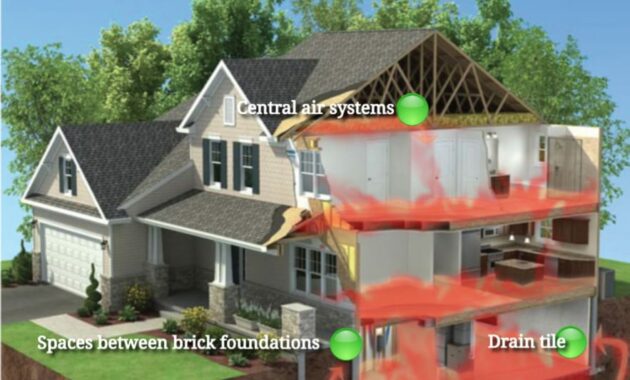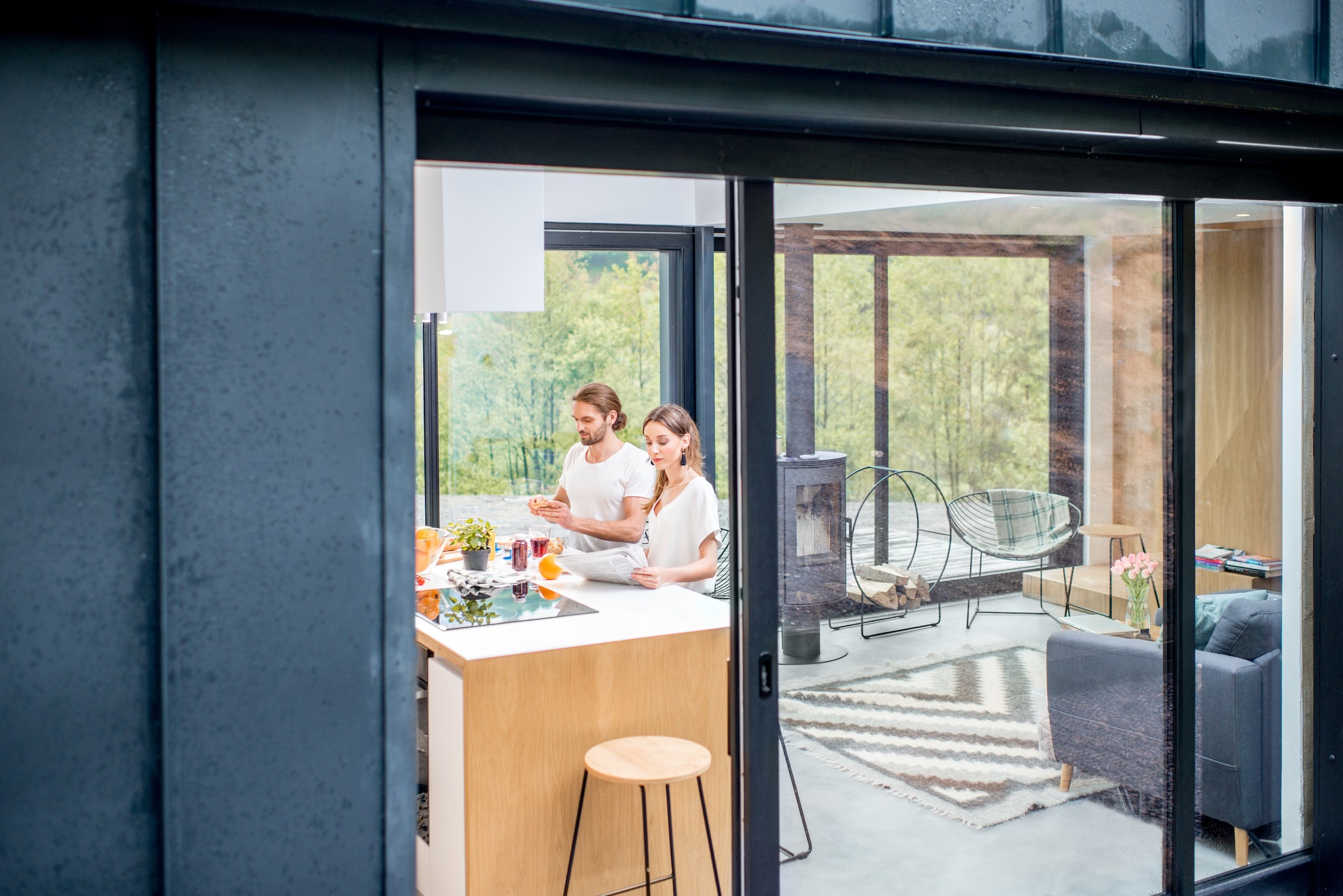If you’re considering buying a house with a radon mitigation system, you’re making a wise decision. Radon, a radioactive gas, is the second leading cause of lung cancer in the United States. It’s an invisible, odorless, and tasteless gas that can seep into homes from the ground, especially in areas with inadequate ventilation.
Radon mitigation systems are designed to reduce radon levels in homes, providing a safer living environment. Scientists estimate that radon causes up to 20,000 lung cancer deaths each year. Therefore, a house with a radon mitigation system is not just a home; it’s a health investment.
The EPA recommends taking action to reduce radon in homes that have a radon level at or above 4 picocuries per liter (pCi/L) of air. Approximately one in 15 U.S. homes is estimated to have radon levels at or above this EPA action level. A radon mitigation system in your house means you’re ahead of the curve, ensuring your home is not contributing to these statistics.
Interestingly, radon was first identified as a health problem when scientists noticed that underground uranium miners exposed to it died of lung cancer at high rates. This led to extensive research and ultimately the development of radon mitigation systems for homes.
Radon can enter homes through cracks in floors, walls, or foundations, and collect indoors. A radon mitigation system works to reduce this indoor accumulation, providing you with peace of mind. It’s like having a silent, always-on guard protecting your family’s health.
Moreover, radon levels can be higher in homes that are well-insulated, tightly sealed, and/or built on soil rich in uranium, thorium, and radium. If you’re buying a modern, energy-efficient house, a radon mitigation system is a must-have.
In conclusion, buying a house with a radon mitigation system is a smart move. It’s an investment in your health and peace of mind. It’s about knowing that you’re doing everything you can to ensure your home is a safe place to live.
Table of Contents
1. Understanding Radon: The Silent Home Invader

What is Radon?
Radon is a naturally occurring radioactive gas that is colorless, odorless, and tasteless. It’s produced by the breakdown of uranium in soil, rock, and water. Because it’s a gas, radon can move up through the ground and into the air we breathe.
How Does Radon Become a Home Invader?
Radon becomes a ‘home invader’ when it seeps into buildings through cracks and other holes in the foundation. Your home can trap radon inside, where it can build up and become a health hazard. Any home, old or new, well-sealed or drafty, with or without a basement, can have a radon problem.
Why is Radon Dangerous?
Radon is dangerous because it’s radioactive. When you breathe in radon, radioactive particles can get trapped in your lungs. Over time, these particles increase the risk of developing lung cancer. In fact, radon is the second leading cause of lung cancer in the United States, only behind smoking.
Who is at Risk?
Everyone who is exposed to high levels of radon over a prolonged period is at risk. However, smokers are at higher risk because radon exposure can further increase their risk of lung cancer.
2. Radon Mitigation Systems: Your Home’s Silent Guardian
What is a Radon Mitigation System?
A radon mitigation system is a technology installed in homes to reduce the concentration of radon in the indoor air. These systems can be installed in various types of homes, from new constructions to older homes, and can be adapted to work with different foundation types.
How Does a Radon Mitigation System Work?
Radon mitigation systems work by venting radon gas from the soil around your home to the outside, preventing it from entering your home. This is usually achieved through a process called sub-slab depressurization, where a pipe is installed through the foundation slab into the soil or rock below. A fan then draws radon from below the house to the outside, preventing it from entering the home.
Types of Radon Mitigation Systems
There are several types of radon mitigation systems, including active soil depressurization (ASD) systems and passive systems. ASD systems use a fan to actively pull radon from the soil and vent it outside. Passive systems rely on natural airflow for radon reduction and do not require a fan.
Installation and Maintenance
Radon mitigation systems should be installed by a certified radon mitigation professional to ensure they are effective. Once installed, these systems require minimal maintenance, usually just periodic system checks to ensure the fan is operating properly.
Effectiveness of Radon Mitigation Systems
When properly installed and maintained, radon mitigation systems are very effective at reducing radon levels in homes. Most homes can achieve radon levels below the Environmental Protection Agency’s action level of 4 picocuries per liter.
3. The Health Risks of Radon Exposure and The Role of Radon in Lung Cancer
Understanding the Health Risks
Radon exposure poses significant health risks due to its radioactive nature. When inhaled, radon gas breaks down into particles that can embed themselves in the lining of the lungs. These particles are radioactive and can damage lung cells, potentially leading to lung cancer over time.
Symptoms of Radon Exposure
Radon exposure doesn’t present immediate symptoms. The effects, such as lung cancer, often show up after many years. This is why radon is often referred to as a silent killer.
How Does Radon Cause Lung Cancer?
When radon gas is inhaled, it breaks down into radioactive particles that can get trapped in your lungs. As these particles decay, they release small bursts of energy. This can damage lung tissue and lead to lung cancer over the course of many years.
Reducing the Risk
The best way to reduce the risk of radon-induced lung cancer is to reduce radon levels in your home. This can be achieved by installing a radon mitigation system. Regular testing for radon is also important to ensure levels remain low.
4. Radon Mitigation Systems Increase Property Value
Understanding the Value of a Radon Mitigation System
A radon mitigation system is a valuable asset to any home. It’s a clear sign that the homeowners have taken proactive steps to ensure the safety and health of those living in the house. This can be a strong selling point when it comes time to put the house on the market.
How Radon Mitigation Systems Enhance Property Value
When potential buyers see that a home has a radon mitigation system, they can feel confident that the house is safe from the dangers of radon. This peace of mind can translate into a willingness to pay a higher price for the property.
The Cost-Benefit Analysis
While there is an upfront cost to installing a radon mitigation system, the increase in property value and the potential for a quicker sale can offset this expense. Additionally, the cost of a radon mitigation system is often less than other home improvements that can increase property value.
The Role of Radon Testing in Property Transactions
Radon testing is becoming more common in real estate transactions. If high levels of radon are found during a home inspection, it can delay or even derail a sale. Having a radon mitigation system in place can prevent these issues, making the home-buying process smoother.
A Long-Term Investment
In the end, a radon mitigation system is a long-term investment in the property. It not only increases the home’s value but also protects the health of all who live there. It’s a win-win situation for both the homeowner and potential buyers.
5. Radon Mitigation Systems are Cost-Effective
Comparing Costs: Radon Mitigation vs. Health Care
Long-term exposure to high levels of radon can lead to serious health issues, most notably lung cancer. The costs associated with treating lung cancer, including medical bills and loss of income, can be significant. In contrast, the one-time cost of installing a radon mitigation system is much lower.
The Value of Prevention
Prevention is always more cost-effective than treatment. By installing a radon mitigation system, you’re taking a proactive step to prevent a potential health crisis. This not only saves potential future healthcare costs but also provides peace of mind.
Potential for Energy Savings
Some radon mitigation systems can also improve the energy efficiency of your home by reducing the amount of unconditioned air entering your home. This can lead to lower heating and cooling costs, providing additional savings.
6. Radon Mitigation Systems are Environmentally Friendly
Understanding the Environmental Impact of Radon Mitigation Systems
Radon mitigation systems are designed to reduce the concentration of radon in indoor air, thereby reducing the risk of lung cancer. But beyond this health benefit, these systems are also environmentally friendly. They don’t use chemicals or produce harmful byproducts, making them a green choice for radon reduction.
No Chemicals or Harmful Byproducts
Radon mitigation systems work by venting radon gas from the soil around your home to the outside, preventing it from entering your home. This process doesn’t involve the use of any chemicals, so there’s no risk of chemical pollution or harmful residues.
Energy Efficiency and Radon Mitigation
Some radon mitigation systems can also improve the energy efficiency of your home. By sealing cracks and other entry points for radon, these systems can also prevent conditioned air from escaping and unconditioned air from entering your home. This can lead to lower heating and cooling costs, contributing to the overall energy efficiency of your home.
A Sustainable Choice
Choosing a radon mitigation system is a sustainable choice. Not only does it protect the health of your family, but it also respects the environment. It’s a solution that benefits both people and the planet.
Investing in a Green Home
Installing a radon mitigation system is an environmentally friendly decision. It’s an investment in a green home, contributing to a healthier environment for everyone.
7. Radon Mitigation Systems are Quiet and Unobtrusive
The Quiet Operation of Radon Mitigation Systems
One of the benefits of radon mitigation systems is their quiet operation. These systems use a fan to draw the radon from the soil and vent it outside, and modern systems are designed to do this with minimal noise. This means you can enjoy a safer home without any disruptive noise.
Unobtrusive Installation
Radon mitigation systems are typically installed in areas of the home where they won’t be noticed, like the basement or attic. The piping used for these systems can often be routed through the interior of the home or outside, depending on the specific layout of the house. This makes the system unobtrusive and minimally invasive to your living space.
Minimal Impact on Home Aesthetics
While the primary purpose of a radon mitigation system is to improve the safety of your home, care is also taken to ensure the system doesn’t negatively impact the aesthetics of your home. The components of the system, including the fan and vent pipe, can be installed in inconspicuous locations to maintain the visual appeal of your home.
Peace and Quiet with Radon Mitigation
In conclusion, a radon mitigation system offers peace of mind without disturbing your peace and quiet. It’s a silent guardian that works unobtrusively to keep your home safe from radon, allowing you to enjoy your living space without worry.
8. Radon Mitigation Systems are Adaptable
Adapting to Different Home Designs
Radon mitigation systems are versatile and can be installed in various types of homes, from new constructions to older homes. The design of the system can be adapted to fit the unique characteristics of each home, including the size, layout, and foundation type.
Working with Different Foundation Types
Whether your home has a basement, or a crawl space, or is built on a slab-on-grade foundation, a radon mitigation system can be designed to effectively reduce radon levels. The system works by creating a vacuum under the foundation to draw the radon out from the soil and vent it safely outside.
Customizing for Optimal Performance
The placement of the system’s components, such as the suction points and the exhaust vent, can be customized based on the design of your home. This ensures that the system works effectively to reduce radon levels, regardless of your home’s design or construction.
Adaptable for Future Home Improvements
If you plan to make future improvements to your home, such as finishing a basement, the radon mitigation system can be adapted to accommodate these changes. This ensures that your home remains protected from radon, even as your home evolves over time.
9. Radon Mitigation Systems are a Testament to Responsible Homeownership
A Sign of Proactive Home Maintenance
Having a radon mitigation system installed in a home is a clear sign of responsible homeownership. It shows that the homeowner has taken proactive steps to ensure the safety and health of those living in the house. This level of care and attention to detail is a positive attribute that potential buyers may appreciate.
Prioritizing Health and Safety
Installing a radon mitigation system is a testament to a homeowner’s commitment to health and safety. By addressing the potential risk of radon, the homeowner is prioritizing the well-being of their family and future occupants of the home.
Responsible Decision Making
The decision to install a radon mitigation system is a responsible one. It shows that the homeowner is informed about potential risks and is willing to take necessary measures to mitigate them. This responsible decision-making is a positive reflection on the homeowner.
10. Radon Mitigation Systems is a Wise Investment
Investing in Health and Safety
When buying a house, a radon mitigation system is a wise investment. It’s an investment in health and safety, providing protection against the second leading cause of lung cancer in the United States. This system works silently in the background, reducing radon levels and providing a safer living environment.
Increasing Property Value
Homes with radon mitigation systems can be more appealing to buyers who are informed about radon risks. This can potentially increase the property value and make the house easier to sell in the future. Thus, buying a house with a radon mitigation system can be a smart financial decision.
Reducing Future Costs
Installing a radon mitigation system after purchasing a house can be a significant expense. Buying a house that already has a system installed can save you this cost. Plus, it can also save potential healthcare costs associated with long-term radon exposure.
Peace of Mind
Beyond the financial considerations, buying a house with a radon mitigation system offers peace of mind. You can move into your new home knowing that you’re protected from the risks of radon exposure.
A Smart Decision for Home Buyers
In conclusion, buying a house with a radon mitigation system is a wise investment. It’s an investment in your health, your future, and your peace of mind. It’s about more than just buying a house; it’s about creating a safe and healthy home for you and your family.
Conclusion
As you navigate the home-buying process, it’s essential to consider all aspects of a potential home, including its safety features. A radon mitigation system is one such feature that should not be overlooked. It’s a testament to responsible homeownership, a sign that the previous owners took the necessary steps to ensure the home was safe. This can give you peace of mind about other aspects of the home’s maintenance and care.
Investing in a home with a radon mitigation system is a wise decision. It’s not just about buying a house; it’s about investing in your health and your future. It’s about knowing that you’re doing everything you can to ensure your home is a safe place to live. And in today’s world, where health and safety are paramount, this is an investment worth making.
A house with a radon mitigation system is more than just a home; it’s a health investment. It’s a testament to responsible homeownership and a wise investment for potential home buyers. So, if you’re asking, “Should I buy a house with a radon mitigation system?” the answer is a resounding yes. It’s a decision that prioritizes health, safety, and peace of mind, making it a smart move for any home buyer.
Discover more from Futurist Architecture
Subscribe to get the latest posts sent to your email.




